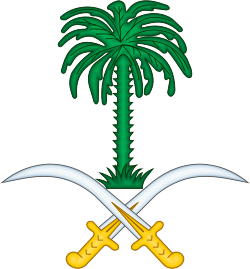National Anthem of Saudi Arabia
The "National Anthem of the Kingdom of Saudi Arabia" (Arabic: النشيد الوطني السعودي, an-Našīd al-Waṭanī as-Saʿūdī, lit. '"Chant of the Saudi Nation"') was first officially adopted in 1950 without lyrics. The piece was gifted by the then Egyptian King Farouq when King Abdulaziz made a visit to Egypt.[1] It was then adopted again in 1984 with lyrics written by Ibrāhīm Khafājī. The original composition was by Abdul-Raḥman al-Khaṭīb in 1947 and the brass instrumental version was later arranged by Sirāj Umar.[2][3][4]
| English: "National Anthem of Saudi Arabia" | |
|---|---|
| النشيد الوطني السعودي | |
National anthem of | |
| Also known as | سارعي (English: "Hasten") النشيد الوطني (English: "The National Anthem") |
| Lyrics | Ibrāhīm Khafājī, 1984 |
| Music | Abdul-Raḥman al-Khaṭīb (arranged by Sirāj Umar), 1947 |
| Adopted | 1950 (as instrumental) |
| Readopted | 1984 (with lyrics) |
| Audio sample | |
"as-Salām al-Malakī" (instrumental)
| |
Overview
In 1947, because Saudi Arabia did not have a national anthem like many states did, King Abdulaziz visited Egypt and asked Egyptian composer Abdul-Raḥman al-Khaṭīb to create a national anthem, and thus "Āsh al-Malīk" was created. The melody is based on an Arab fanfare style, and is similar to the national anthems of other Arab states in the area at the time. In 1958, Mohammed Talat wrote the first set of lyrics which were not often heard, so King Fahd asked poet Ibrāhīm Khafājī in 1984 to come up with a new set of lyrics, which were completed within six months on 29 June 1984.[4] Khafājī's lyrics are the ones that are used officially today.[2] Saudis listened to their anthem for the first time during the celebrations of Eid ul-Fitr in 1984.[5]
"Āsh al-Malīk" is referred to by Saudi Arabians as "The National Anthem" (النشيد الوطني, an-Našīd al-Waṭanī), although it is commonly known by its incipit, "Hasten" (سارعي, Sārʿī). The lyrics call upon the country to hasten to greatness and raise the flag, glorify God, and asks Him to grant the King of Saudi Arabia long life.[4]
The instrumental version is called the "Royal Salute" (السلام الملكي, as-Salām al-Malakī) which is also the name of the ceremony in which it is played to salute senior members of the royal family as well as diplomatic figures.
Lyrics
| Arabic Script | MSA Romanization | Phonemic Transcription (IPA) | English translation |
|---|---|---|---|
سَارْعِي وَارْفَعِي الْخَفَّاقَ الْأَخْضَر !يَا مَوْطِنِي ،مَوْطِنِي |
Sārʿī |
[saːriʕiː] |
|
Notes
- "Allahu Akbar" is Arabic for "God is the Greatest", but is expressed the same way by every Muslim in the world, regardless of their native language.
References
- "A history of the Saudi national anthem". gulfnews.com. Retrieved 2019-02-08.
- http://www.nationalanthems.info/sa.htm
- "نشيد العلم السعودي.. قصة خلدها التاريخ". Sayidaty.net (in Arabic). 2017-09-15. Retrieved 2019-01-11.
- Al Ash-Shaykh, Malik (2018-09-23). "5 facts you should know about Saudi Arabia's national anthem". Stepfeed. Retrieved 2019-01-11.
- "A history of the Saudi national anthem". gulfnews.com. Retrieved 2019-02-08.
- "أخطاء السلام الوطني وتقصير التربويين!". Makkah Newspaper (in Arabic). 2016-09-16. Retrieved 2019-01-11.
- http://vb.alhilal.com/t769744.html
- https://www.al-madina.com/article/133558
External links
| Wikisource has original text related to this article: |
- Saudi Arabia: an-Nasheed al-Waṭaniy – Audio of the national anthem of Saudi Arabia, with information and lyrics
- The Royal Embassy of Saudi Arabia in Washington, DC has an Audio page that includes the National Anthem in both vocal and instrumental versions.
- https://gulfnews.com/world/gulf/saudi/a-history-of-the-saudi-national-anthem-1.2281470
